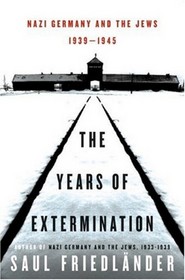Search -
The Years of Extermination: Nazi Germany and the Jews, 1939-1945
The Years of Extermination Nazi Germany and the Jews 19391945
Author:
From Publishers Weekly: — In the second volume of his essential history of Nazi Germany and the Jews, one of the great historians of the Holocaust provides a rich, vivid depiction of Jewish life from France to Ukraine, Greece to Norway, in its most tragic period, drawing especially on hundreds of diaries written by Jews during their ordeal, depic... more »
Author:
From Publishers Weekly: — In the second volume of his essential history of Nazi Germany and the Jews, one of the great historians of the Holocaust provides a rich, vivid depiction of Jewish life from France to Ukraine, Greece to Norway, in its most tragic period, drawing especially on hundreds of diaries written by Jews during their ordeal, depic... more »
ISBN-13: 9780060930486
ISBN-10: 0060930489
Publication Date: 4/1/2008
Pages: 896
Rating: 2
ISBN-10: 0060930489
Publication Date: 4/1/2008
Pages: 896
Rating: 2
4.5 stars, based on 2 ratings
Genres:




